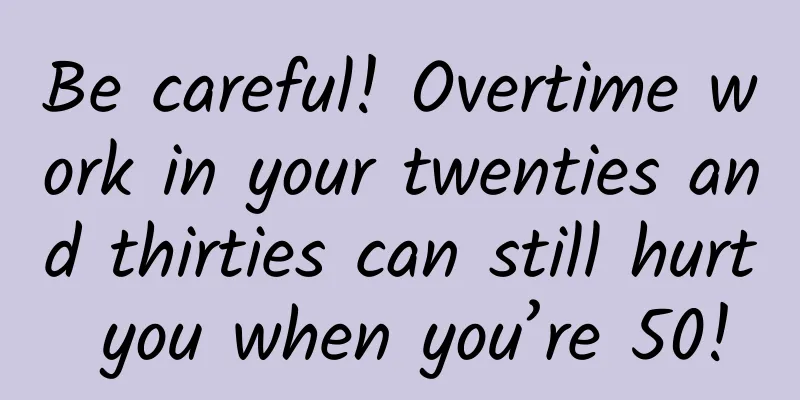Be careful! Overtime work in your twenties and thirties can still hurt you when you’re 50!

|
Overtime work is a problem that modern people do not want to touch but cannot completely avoid. Recently, a study published in the Public Library of Science: One (PLOS One) brought another bad news. If you need to work overtime and often leave work at irregular times, it may have an adverse effect on your physical and mental health. Copyright images in the gallery. Reprinting and using them may lead to copyright disputes. A nearly 30-year investigation The "9 to 5" we often talk about is actually standard working hours. If you are not "9 to 5", then it is "non-standard working hours" - nearly one-third of the world's people are in a state of "non-standard working hours". Previous studies have shown that people who work "non-standard working hours" for a long time will have worse health, affected sleep quality, and are associated with the occurrence of cardiovascular and mental illnesses. But the data of this study is more special. It uses data from a long-term follow-up survey called the "Longitudinal Survey of American Youth." How our longitudinal employment patterns affect our health in midlife - the US NLsY79 cohort The survey has been conducted annually (every two years after 1994) with more than 12,000 samples since 1979. As of 2018, most people have reached the age of 50. So this study had enough data to examine how people's work patterns from ages 22 to 49 affected their health at age 50. In the survey, the researchers divided the subjects into five types: The first category is called "standard working hours", which means starting work at 6 o'clock or later every day and finishing at 6 o'clock every afternoon. The so-called 9 to 5 people belong to this category (it seems to be the best in this category). For the sake of convenience, we will call this group of people "9 to 5" from now on. The second and third categories are “late shift” and “night shift” respectively. Note that in the study, late shift and night shift are not the same concept. Late shift refers to work that starts at 2 pm or later and ends at around midnight. Night shift refers to work that starts at 9 pm or later and ends at 8 am the next day. The fourth category is uncertain work patterns , which include shifts, on-call, or other irregular working hours. The fifth category is easier to understand, which is not going to work . In the study, about 26% of people were always working a 9-to-5 job. 35% of people work from 9 to 5 most of the time, but occasionally work night shifts, late shifts or have uncertain working hours. 17% of people worked from 9 to 5 in their 20s, but later switched to working indeterminate hours. For the sake of distinction, we call them the "9 to 5 to indeterminate group." Another 12% of people worked from 9 to 5 in their 20s, but later switched to night shifts, late shifts, or indeterminate work patterns. It is worth noting that this group of people later had more variable work schedules, which may mean that their jobs are more unstable. Similarly, in order to distinguish them from the previous group, we call them the "9 to 5 to hustle group" Another 10% of people are not working most of the time. Working hours distribution of different types of people Image source: Reference 4 How do working hours affect your health? So what impact do working hours have on health? The researchers evaluated the situation from several dimensions, including sleep duration, sleep quality, physical health, mental health, and depressive symptoms. Let’s take a look at each one separately. 1 Sleep duration and sleep quality Judging from the average sleep time, the group with the longest average sleep time is not the "non-working group" but the "9-to-5 group", with an average sleep time of 7.08 hours per week. The second group is those who work from 9 to 5 most of the time and occasionally do other things. The average sleep duration per week for this group is 6.93 hours. The worst group was the "9-to-5 group", with an average sleep duration of only 6.76 hours. The "non-work group" was surprisingly ranked second to last, with an average sleep duration of only 6.79 hours. The same trend is seen for sleep quality. The group with the best sleep quality is also the "9-to-5 group", but the group with the worst sleep quality is the "non-work group". The "9-to-5 group" ranks second to last. Judging from the situation of the "non-working group", not working does not bring people better sleep. Average sleep duration for different working hours, gender, and education level. Image source: Reference 4 2 Physical and mental health For physical health and mental health, the trends were similar to those for sleep. As for physical health, only 12.61% of the "9-to-5 group" felt that their health was not good. 23.21% of the "9-to-5 group" felt that their health was not good, while 34.26% of the "non-working group" felt that their health was not good. The proportion of people who feel “poor physical condition” according to different working hours patterns, gender and education level. Image source: Reference 4 The mental health scores also showed a similar trend. In the test of scoring depression symptoms, the "9-to-5 group" scored only 11.23. The "9-to-5 group" scored 17.62, while the "non-work group" scored 27.98 (the lower the score, the milder the depression symptoms, and more than 16 points means possible depression). Depression symptom scores for different working hours patterns, gender, and educational level ratios Image source: Reference 4 Therefore, whether in terms of sleep duration, sleep quality, physical or mental health, the "9 to 5 group" is the best, and if the "non-work group" is excluded , the "9 to 5 group" is the worst among all work modes. The "9-to-5 group" may be related to middle-aged unemployment. To avoid middle-aged unemployment, it involves not only personal efforts but also social factors. It is a complex and difficult direction to start. However, there are some work patterns that are harmful to health that we can actively identify and avoid. For example, the "night shift" work pattern mentioned in this study is a work pattern that has been clearly harmful to health. 3 Does night shift cause cancer? In 2019, the International Cancer Agency classified "night shift work" as a Class 2A carcinogen, the same level as inorganic lead compounds, DDT, high-temperature fried foods, red meat, and hot water over 65 degrees Celsius. Image source: Reference 5 According to a study by the American Cancer Society (AACR), staying up late may increase women's risk of cancer by 19%. The risk of skin cancer will increase by 41%, the risk of breast cancer will increase by 32%, and the risk of gastrointestinal cancer will increase by 18%. In addition to the risk of cancer, night shift work may also be associated with type 2 diabetes, heart disease, stroke, and some mental illnesses. Therefore, during work, if you can avoid working night shifts, try to avoid them. For those who cannot avoid working night shifts, such as doctors and nurses who need to work night shifts frequently, they need to undergo regular physical examinations to detect physical abnormalities as early as possible. In addition, after working the night shift, you should pay attention to rest and ensure adequate sleep before engaging in daytime activities. As for those who do not need to work night shifts but choose to stay up late, I can only advise everyone to cherish every sleep they get. References [1] https://m.caijing.com.cn/api/show?contentid=4984745 [2] DT Finance, “2023 Young People’s Overtime Research Report” [3] 36Kr, Houlang Research Institute, “2021 Young People’s Off-get off work Behavior Report” [4] Han W J. How our longitudinal employment patterns might shape our health as we approach middle adulthood—US NLSY79 cohort[J]. PLoS one, 2024, 19(4): e0300245. [5]https://www.iarc.who.int/wp-content/uploads/2019/07/QA_Monographs_Volume124.pdf [6]https://www.iarc.who.int/featured-news/aspartame-hazard-and-risk-assessment-results-released/ Planning and production Author: Science Scraps Popular Science Creator Reviewer: Tang Qin, Director and Researcher of the Science Popularization Department of the Chinese Medical Association Planning|Yang Yaping Editor: Yang Yaping Proofread by Xu Lailinlin |
<<: Just by adding an A to 5G, can we enter the "10 Gigabit Era"?
>>: Fun Fact: Cherry blossoms, the most popular flower in spring, actually originated in China
Recommend
How do you make a blessing video from foreigners? How do you make a blessing video from black people?
Nowadays, there are more and more birthday gifts ...
Android View related core knowledge questions and answers
The author shared his understanding of View-relat...
How to advertise ethically during APP promotion
Whether a product can last long depends first on ...
[Smart Farmers] How to check if fruits are "injured"? Fruit "Doctor" is now online!
In modern agriculture and food production, ensuri...
iOS WeChat update: The withdrawal time can be extended to three hours
Yesterday, iOS WeChat updated to version 8.0.40, ...
The Alpha S5, which starts at RMB 176,800, is a product with a good balance of quality and price, but its brand is its biggest shortcoming.
During this period, BYD was the most active manuf...
What to do when SEM bidding promotion encounters negative SEO news?
What to do when SEM bidding promotion encounters ...
Mr. Yuefeng 20211128 Mr. Yuefeng's lecture internal training part 2 video
Mr. Yuefeng 20211128 Mr. Yuefeng's lecture in...
"Sending away poverty" and "welcoming wealth" - how to correctly welcome the God of Wealth on the fifth day of the first lunar month?
The fifth day of the first lunar month is an impo...
Hot search! 2-year-old boy faces amputation, just because he went to the vegetable market? Doctors urgently remind →
Recently, the topic #2-year-old child infected wi...
China Association of Automobile Manufacturers: Analysis of Chinese brand passenger car sales in January 2023
According to statistics and analysis by the China...
Recommended flower-viewing routes along the Central Axis, including flower-viewing guides for 111 Beijing parks!
The Qingming Festival holiday is coming soon. Hav...
Promotional event: the process of bargaining for popular products!
As early as 2016, price-cutting reached a small c...
Great Wall WEY's fuel consumption fraud scandal continues, and its core technology is still not up to standard
As a typical representative of the upward movemen...
【Creative Cultivation Program】In fact, it is your stomach that controls your brain!
Author: Chen Wen Reviewer: Associate Professor Ta...




![WordPress personal website building tutorial, WordPress website building tutorial complete set of twelve sections [Directory]](/upload/images/67cc4fcc23f4a.webp)




